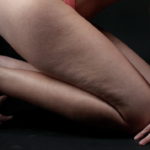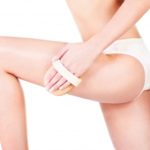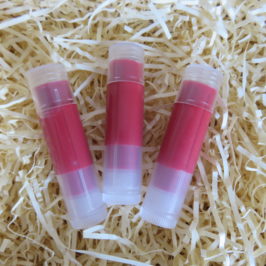This post may contain affiliate links. If you make a purchase through a link, I may receive a small commission, at no cost to you. These commissions help keep this website up and running, and I thank you for your support. Read my full disclosure here.
Disclaimers: I have in no way been influenced or paid to endorse these products. All recommendations are my own.
I am not a medical professional. Talk to your doctor before attempting any treatments that may affect your health.
Contrary to popular belief, cellulite is not a modern condition or a disease. It’s actually a normal part of our body and is prevalent in up to 90% of women. In fact the term ‘cellulite’ was first used back in the 1920’s by a French beauty spa in order to promote their services. It later became more widespread in the 1960’s when it was used in women’s magazines. Since then cellulite has remained a hot topic and the constant media shaming that occurs in magazines and gossip websites further perpetuates our belief that it is an unacceptable part of our body that we simply must get rid of. It has become a billion dollar industry that thrives on making it an embarrassing affliction. No wonder we are so obsessed about getting rid of it!
In this article I will outline:
- What is cellulite
- Available cellulite treatments, how they work and whether research supports their efficacy (be prepared for some disappointment)
- How to reduce cellulite
- Quick fixes that can improve the appearance of cellulite
What Is Cellulite?
In simple terms, cellulite is the fat that sits in the superficial layer of our body. It is dimpled in its appearance because the fat is bulging through the fine mesh of fibrous connective tissue that sits beneath the skin surface and keeps it in place.
Why Do We Get Cellulite?
You don’t need to be overweight to have cellulite, even super slim models have it. Due to hormonal and reproductive reasons, women tend to store their fat around the hips, stomach, bum and thighs which are areas that are prone to cellulite. This is also why cellulite usually appears around adolescence. Although men can have cellulite, it is more common in woman because the fibrous structure that supports their fat and fat cells is different.
We all have fat on our body, but where and how we carry it is hereditary. To understand this, think about the five main body shapes commonly used to describe our overall silhouette; pear, hourglass, rectangle, apple and inverted triangle. We get these body shapes passed down to us from our family and this helps to explain why some of us have more fat in certain areas than others.
Other factors, like lack of exercise and unhealthy eating can lead to you being overweight. Typically, the more fat that you are carrying the more pronounced your cellulite will be. A lack of regular exercise can also limit fluid movement and drainage which can contribute to its appearance.
Why Does Cellulite Look Worse as We Age?
After about 30 years of age our dermis, which is held together by connective tissue, starts to get looser and lose its thickness. This is because our collagen and elastic fibres begin to age. This can also coincide with a time in our lives where we may not be maintaining a healthy eating and exercise regime because of children and busy careers which can further exacerbate it.
What Are the Current Treatments for Removing and Reducing Cellulite and Do They Work?
Unfortunately it is very difficult to find any honest, unbiased and trustworthy advice because the professionals in the industry including doctors, beauticians and scientists have a vested interest in developing and promoting treatments that can make them a lot of money. There are a huge range of treatments available, but most are expensive and typically require numerous treatments to ‘work’. Furthermore, unless the treatments are regularly carried out, at great cost to the consumer, then any improvement is lost. Below are the common and popular treatments currently in use:
Massage
Massage can temporarily improve the appearance of cellulite by removing some of the fluid from the area. If you try this treatment, then ensure that the massage is gentle and does not cause pain, otherwise it could cause more damage than good. Be aware that if you do experience any improvement, it will be temporary and you will need to continue the treatments to maintain it.
Mechanical Massage and Suction
Mechanical massage and suction is typically carried out using a handheld device that sucks the skin between rollers which squeeze it. It is usually referred to as Endermology or Endermologie and is supposed to improve cellulite by increasing blood and lymphatic flow and stretching out the fibrous tissue. In reality, independent research has shown that it just causes minor swelling and movement of fluid which temporarily disguises the cellulite. Some patients also experience bruising. When the treatments cease, the swelling subsides and the fluid and cellulite return. As it requires many sessions (about 10), you will end up significantly out of pocket and most likely disappointed.
Radiofrequency (RF) Devices
Radiofrequency (RF) devices, e.g. Thermage, are non-invasive (no needles or surgery) and designed to project radio waves into the layers of skin. These devices are combined with a laser to produce heat alongside the radio waves to help it penetrate deeper. It’s supposed to stimulate collagen to help smooth, tighten and contour the treated areas, but there is no evidence that it can improve cellulite.
Ultrasound
Ultrasound is a non surgical treatment that is supposed to lift and tighten the skin. However, there is no scientific research to support it being an effective treatment for cellulite.
Subcision
Subcision is a surgical treatment where a needle is used to severe through the fibrous tissue to free the fat. There is no evidence that this treatment is effective.
Cellulaze
Cellulaze is an FDA approved treatment that uses laser. While under local anaesthesia, a small fibre optic laser is inserted under the skin via a small incision. The laser is used to melt the fat cells and cut through the fibrous bands to release the fat pockets. Patients report it as being a painful procedure and afterwards you will need to wear compression garments to assist with the healing. Some patients see an improvement in the appearance of their cellulite, but many report no change or even feel that it has made it worse. Patients may also experience side effects such as prolonged pain and sensitivity to the treatment area. There is still no sound medical research supporting this as a safe and effective treatment for cellulite.
Injectables
Injectables, commonly called fat-melting injections, lipolysis or mesotherapy. This treatment involves injecting a cocktail of untested chemicals multiple times into the fat to dissolve it. Due to the reported side effects involving tissue death and infection, they have been banned in some countries. The drug commonly used in this treatment is phosphatidylcholine, an extract of lecithin from soybeans. This drug can destroy fat cells in animal studies but has not been proven as a safe or effective cellulite treatment. Furthermore, it is known to cause serious side effects such as ulcers and bleeding.
Liposuction
Liposuction may reduce the fat in the area being treated, but it can also make cellulite appear worse by forming dents. To counteract this, some physicians inject fat (usually your own) back into these dented areas. However, this has been known to cause lumpiness.
Detoxing
Detoxing will not remove cellulite because cellulite is not caused by toxins.
Dry Brushing
Dry brushing involves vigorously brushing your cellulite with a body brush made of boar bristles to promote circulation and remove toxins. But because cellulite is not caused by either of these things, dry brushing will not improve your cellulite. However, it is great for your circulation, so it’s still recommended.
Body Wraps
Body wraps are basically a tight compression bandage that is wrapped around your body, usually in conjunction with special creams and lotions that are supposed to assist in the process. To ‘prove’ the treatment works, you are measured before and after. Tight compression does reduce the size of the area temporarily because it pushes the fluids out into the other non compressed areas. However, it quickly returns and does not reduce cellulite. I’m sure you have noticed this same affect when you have worn a tight pair of socks, especially those with a tight band. After removing them, you will have observed a compressed area where the tight band sat, but it doesn’t take long for this area to return to its normal size.
Dietary Supplements
Dietary supplements such as fish oil, ginkgo biloba, grape-seed bioflavinoids etc… (the list is long) have been promoted as boosting metabolism, improving circulation, and breaking down fats. However, there is no research that supports supplements as an effective way to reduce cellulite. In fact, some of them may interact with prescription drugs and do more harm that good.
Creams and Lotions
Creams and lotions may improve the surface texture of your skin but won’t remove the cellulite. Some creams even contain ingredients that cause your skin to slightly swell to mask the cellulite, but this of course quickly wears off. Most of the creams are not even absorbed through the skin into the fat, so have no way of being effective. In fact, the research carried out on cellulite creams have shown that they work no better than simply massaging the skin which on its own can improve the appearance of cellulite by removing some of the fluid from the area. Consequently, any positive effects are temporary and will cease once you stop using them.
More recently, there have been two types of cream that have been very popular:
- Retinoid creams have been shown to improve the appearance of cellulite in some women by thickening the skin so that it is more masked. But there is much disagreement as to whether it reliably improves the appearance of cellulite.
- A study found that cream containing Methyxanthines, found in the compounds aminophylline, caffeine or theophyilline, slightly reduced thigh circumference for some people. Although these chemicals have been shown to break down fat, further research has failed to show that these creams can penetrate through to the cellulite and provide any significant cellulite reduction. In fact, most people who use these creams find no improvement.
- If you are keen to give the cellulite creams a go, then try HD Skin Care Intensive Cellulite Serum which contains both retinol, and caffeine and is reasonably priced.
How to Reduce Cellulite
Try these key methods:
- Avoid cigarettes and excessive alcohol.
- Improve your diet by eating healthy low fat food and increasing your vegetable and fiber intake.
- Eliminate trans fats from your diet (e.g. packaged foods, fried foods, commercially prepared baked goods) and reduce the amount of saturated fats (e.g. butter and animal fats).
- Reduce your salt intake as it can cause fluid retention.
- Try to avoid eating junk food, processed foods and sugar.
- Drink lots of water, it not only suppresses your appetite but also provides you with the essential hydration your body needs to boost your metabolism and assist with weight loss.
- Avoid caffeinated drinks such as coffee, tea and coke. They act as diuretics and can affect your ability to lose weight.
- Avoid soda and fruit juices as they are high in sugar.
- Avoid artificial sweeteners (e.g. diet soda) as they can trigger insulin which encourages your body to store fat, resulting in weight gain.
- Partake in regular exercise to help burn calories and excess body fat as well as reduce water retention.
- Try not to sit for prolonged periods, as this can cause water retention and poor circulation. Get up and walk around. Try setting a timer to help you remember.
- Incorporate strength training into your workouts at least 3 days a week. If the muscle behind the fat is weak, it can make cellulite appear bumpier. (Strength training also has the added benefit of improving bone density which is essential in woman to protect bones and prevent osteoporosis.)
Unfortunately there is currently no treatment that reliably removes cellulite. Maintaining a healthy weight and lifestyle can reduce the appearance of cellulite, but, before getting your hopes up be aware that in some people weight loss can actually make the cellulite look worse. This is usually because the skin has lost its elasticity and become ‘saggy’, causing the cellulite to appear bumpier and more pronounced. Also, weight loss will not completely remove cellulite because it sits in the superficial layer of your body, which is the last area to be affected by weight loss.
Quick Fixes That Can Temporarily Improve the Appearance of Cellulite
The above strategies are obviously going to take some time and commitment to achieve results. But if you have a special event coming up and need a quick fix, try the following:
- Wear body contouring undergarments to create a smooth look.
- Going away for a beach break? Get a fake tan – it’s great at giving the illusion of less cellulite as well as being a faster and much safer alternative to lying in the sun. Good spray tanners can even create the illusion of contours on the body. For a quick and easy at home tan, try the popular St. Tropez self tanner.
- Leading up to your special event, try getting some gentle massage by a licensed masseuse to improve the appearance of cellulite by removing fluid from the area. But remember, even if this does work, the effects are temporary.
As most of us have cellulite, is it really a problem? Or is it just a normal part of our body that we should learn to accept and love? Personally, I’ve decided to stop battling against my cellulite because I know it’s a waste of my time, energy and money. It has only brought me disappointment and empty pockets. Instead, I try to focus on my health, well being and happiness. I’ve found that as I fill my life with more worthwhile things, I’m so busy enjoying life that I don’t care about it nearly as much as I used to. Next time you’re at the beach, take a moment to look around and see how many other people have cellulite. We are usually so self-obsessed that we don’t even notice what’s around us. You’ll see that most of the women on the beach are also sporting cellulite, so if everybody else has it, why are you so worried about it?













Leave a Reply